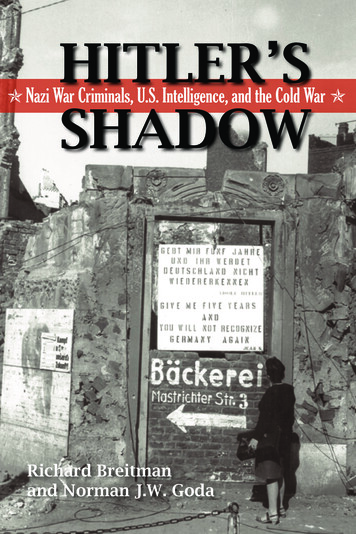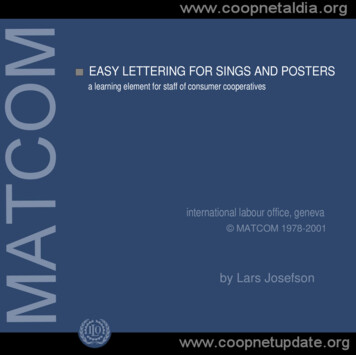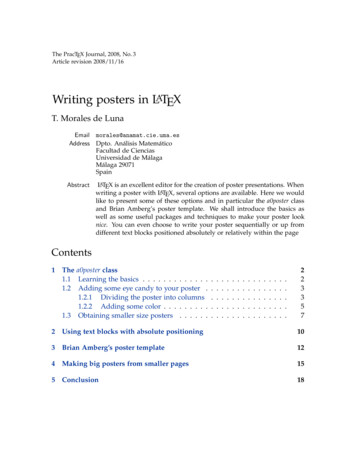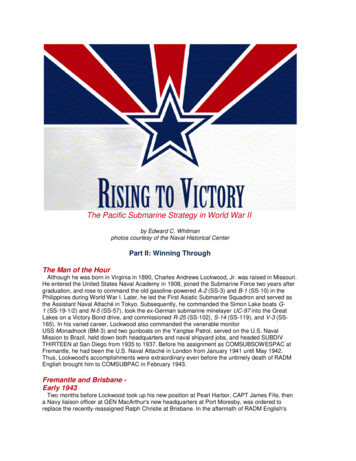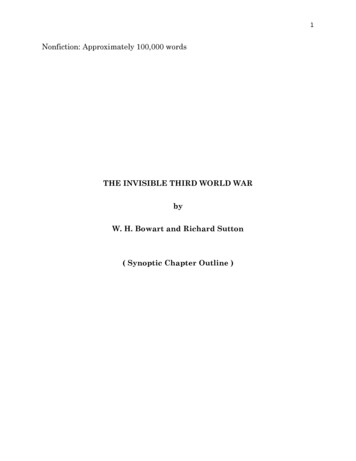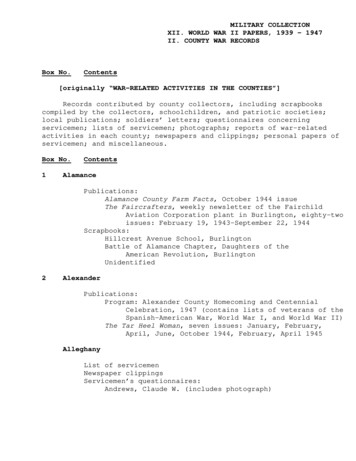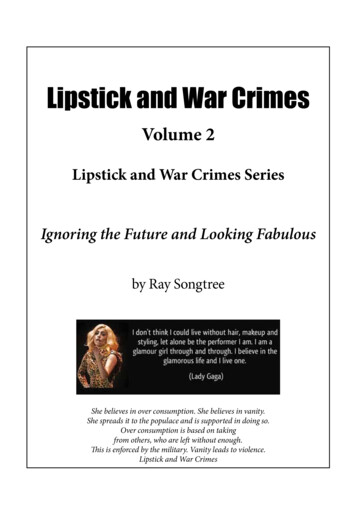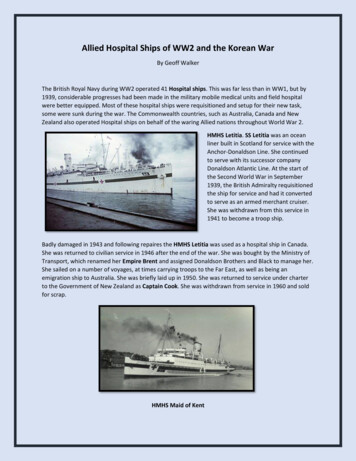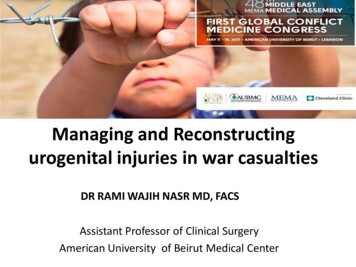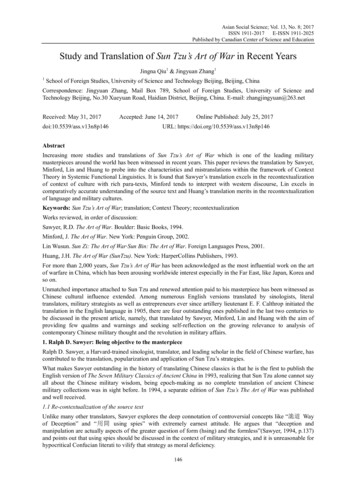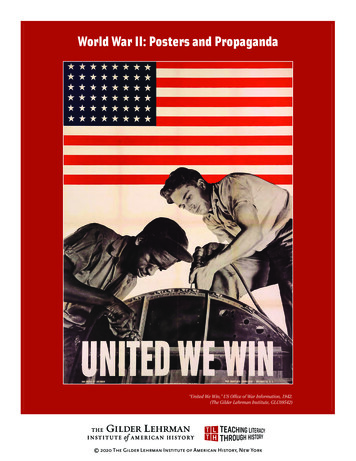
Transcription
World War II: Posters and Propaganda“United We Win,” US Office of War Information, 1942.(The Gilder Lehrman Institute, GLC09542) 2020 The Gilder Lehrman Institute of American History, New York
World War II: Posters and PropagandaBY TIM BAILEYUNIT OVERVIEWThis unit is part of the Gilder Lehrman Institute’s Teaching Literacy through History resources, designed to alignwith the Common Core State Standards. These units were developed to enable students to understand, summarize,and evaluate original texts of historical significance. Through a step-by-step process, students will acquire the skills toanalyze and assess primary and secondary source material.Over the course of the three lessons in this unit, the students will analyze and assess a collection of posters that wereproduced, distributed, and displayed by the United States Office of War Information (OWI) during World War II aspart of a propaganda campaign to encourage American patriotism and mobilize public support for the war effort. Thestudents will examine, explain, and evaluate the meaning, mood, message, and theme of each poster as well as assesshow effective the artist was in fulfilling the poster’s purpose to promote American participation and ultimate victoryin World War II.OBJECTIVESStudents will be able to Analyze primary and secondary source documents Infer subtle messages from primary source artwork and secondary source text Summarize the meaning of an informational text Respond to a thought-provoking essay prompt using textual and visual evidenceESSENTIAL QUESTIONHow did government-sponsored art reflect the priorities and values of American society during World War II?NUMBER OF CLASS PERIODS: 3GRADE LEVELS: 7–12COMMON CORE STATE STANDARDSCCSS.ELA-Literacy.RH.11-12.1: Cite specific textual evidence to support analysis of primary and secondary sources,connecting insights gained from specific details to an understanding of the text as a whole.CCSS.ELA-Literacy.RH.11-12.2: Determine the central ideas or information of a primary or secondary source; providean accurate summary that makes clear the relationships among the key details and ideas.CCSS.ELA-Literccy.RH.6-8.1: Cite specific textual evidence to support analysis of primary and secondary sources.CCSS.ELA-Literacy.RH.6-8.2: Determine the central ideas or information of a primary or secondary source; provide anaccurate summary of the source distinct from prior knowledge or opinions. 2020 The Gilder Lehrman Institute of American History, New York2
CCSS.ELA-Literacy.SL.8.2: Analyze the purpose of information in diverse media and formats (visually, quantitatively,orally) and evaluate the motives (e.g., social, commercial, political) behind its presentation.CCSS.ELA-Literacy.SL.11-12.1: Initiate and participate effectively in a range of collaborative discussions (one-on-one,in groups, and teacher-led) with diverse partners on grades 11-12 topics, texts, and issues, building on others’ ideasand expressing their own clearly and persuasively.CCSS.ELA-Literacy.SL.11-12.2: Integrate multiple sources of information presented in diverse formats and media(e.g., visually, quantitatively, orally) in order to make informed decisions and solve problems, evaluating thecredibility and accuracy of each source and noting any discrepancies among the data.CCSS.ELA-Literacy.W.8.2: Write informative/explanatory texts to examine a topic and convey ideas, concepts, andinformation through the selection, organization, and analysis of relevant content.CCSS.ELA-Literacy.W.8.2.B: Develop the topic with relevant, well-chosen facts, definitions, quotations, or otherinformation and examples.CCSS.ELA-Literacy.W.11-12.2: Write informative/explanatory texts to examine and convey complex ideas, concepts,and information clearly and accurately through the effective selection, organization, and analysis of content.CCSS.ELA-Literacy.W.11-12.2.B: Develop the topic thoroughly by selecting the most significant and relevant facts,extended definitions, concrete details, quotations, or other information. 2020 The Gilder Lehrman Institute of American History, New York3
LESSON 1OVERVIEWIn this lesson, the students will read a secondary source about the purpose and content of posters sponsored bythe US government during World War II. They will then answer critical thinking questions based on the essay. Thefocus of the lesson is on the campaign directed by the Office of War Information to increase and facilitate financingthe war effort, recruiting soldiers, producing war materials, mobilizing loyalty and support, eliminating dissent andopposition, and conserving resources that were essential to the war effort.OBJECTIVESStudents will be able to Read a secondary source text using close reading strategies Explain in their own words themes and messages represented by World War II postersHISTORICAL BACKGROUNDSee “Every Citizen a Soldier: World War II Posters on the American Home Front” by William L. Bird Jr. and HarryRubenstein in the student handouts, page 9.MATERIALS Excerpts from William L. Bird Jr. and Harry Rubenstein, “Every Citizen a Soldier: World War II Posters on theAmerican Home Front,” History Now 14 (Winter 2007), The Gilder Lehrman Institute of American History,gilderlehrman.org/history-now. Critical Thinking Questions: Every Citizen a SoldierPROCEDURE1.Hand out the excerpts from the essay “Every Citizen a Soldier: World War II Posters on the American HomeFront” by William L. Bird Jr. and Harry Rubenstein.2.“Share read” the text with the students by having the students follow along silently while you read aloud,modeling prosody, inflection, and punctuation. Ask the class to join in with the reading after a few sentenceswhile you continue to read aloud. This technique will support struggling readers and English language learners(ELL).3.Hand out the activity sheet for this lesson. Have the students complete the critical thinking questions as theyread the essay. You can model the first two questions with the class before having the students complete theactivity sheet in small groups or individually, depending on the level of support needed by your students.4.Discuss different interpretations developed by the students or student groups. 2020 The Gilder Lehrman Institute of American History, New York4
LESSON 2OVERVIEWIn this lesson, the students will carefully examine ten posters created as propaganda to appeal to the emotions ofthe viewers. The posters, often created by famous artists, exhibit both positive and negative messages to influenceAmericans’ ideas and behavior. As part of this lesson, you will discuss the purposes, methods, and effectiveness ofpropaganda in playing on the viewer’s emotions.OBJECTIVESStudents will be able to Analyze ten primary source posters from World War II Identify themes (from the essay in Lesson 1) represented in each poster using visual and textual evidenceMATERIALS Analyzing a Poster activity sheet World War II Posters #1–#10#1:“He’s Watching You,” art by Glenn Grohe, Office of Emergency Management, 1942. (National Archives)#2:“We Are Ready, What about You? Join the Schools at War Program,” art by Irving Nurick, US TreasuryDepartment, 1942. (Pritzker Military Museum & Library)#3:“Help Win the War, Squeeze In One More,” art by Lee Morehouse, US Office for Emergency Management,ca. 1941–1945. (National Archives)#4:“WARNING! Our Homes Are in Danger Now!” General Motors Corporation, 1942. (National Archives)#5:“Soldiers without Guns,” art by Adolph Treidler, US Office for Emergency Management, 1944. (NationalArchives)#6:“United/United Nations Fight for Freedom,” US Office of War Information, Division of Public Inquiries,1943. (The Gilder Lehrman Institute of American History, GLC09520.30)#7:“United We Win,” US Office of War Information, 1942. (The Gilder Lehrman Institute of American History,GLC09542)#8:“Of Course I Can! I’m Patriotic as Can Be,” art by Dick Williams, US War Food Administration, 1944. (UNTLibraries Government Documents Department, University of North Texas Libraries, Digital Library)#9:“It Can Happen Here!” General Motors Corporation, 1942. (National Archives)#10: “Do with Less, so They’ll Have Enough!: Rationing Gives You Your Fair Share,” US Office of WarInformation, 1943. (The Gilder Lehrman Institute of American History, GLC09520.19) 2020 The Gilder Lehrman Institute of American History, New York5
PROCEDURE1.Hand out World War II Posters #1–#2 and the “Analyzing the Poster” activity sheets.2.You may want to display a list of the six themes described in “Every Citizen a Soldier”:a.The Nature of the Enemyb.The Nature of Our Alliesc.The Need to Workd.The Need to Fighte.The Need to Sacrificef.The Americans3.The students will answer the questions on the activity sheet for each poster. For the first two posters this will bedone as a whole-class activity with discussion. After analyzing the first two posters with the class, hand out posters #3–#10. The students will analyze these posters in small groups, pairs, or individually depending on the levelof support they need. Depending on the time available, you may choose to distribute fewer posters or assign somefor work outside of class.4.Discuss different interpretations developed by the students or student groups. Ask the students to consider howeffective these posters were as propaganda, playing on the emotions of the viewers in wartime. You may wish todisplay these definitions of propaganda from Merriam-Webster:a.the spreading of ideas, information, or rumor for the purpose of helping or injuring an institution, acause, or a personb.ideas, facts, or allegations spread deliberately to further one’s cause or to damage an opposing cause 2020 The Gilder Lehrman Institute of American History, New York6
LESSON 3OVERVIEWIn this lesson, the students will analyze an additional ten posters keeping in mind the themes introduced in Lesson 1.After completing the activity sheets, they will synthesize their knowledge in an argumentative essay addressing thosethemes, citing evidence from the posters and the essay to support their point of view.OBJECTIVESStudents will be able to Analyze 10 primary source posters from World War II Identify themes (from the essay in Lesson 1) represented in each poster using visual and textual evidence Synthesize, analyze, and use visual evidence to present an argument in a short essayMATERIALS Analyzing a Poster activity sheet World War II Posters #11–#20#11: “We’re Fighting to Prevent This,” by the Think American Institute, Rochester NY: Kelly Read & Co.(National Archives)#12: “Your Right to Vote Is Your Opportunity to Protect,” by the Think American Institute, Rochester NY: KellyRead, ca. 1943. (Library of Congress Prints and Photographs Division)#13: “Plant a Victory Garden,” art by Robert Gwathney, US Office of War Information, 1943. (UNT LibrariesGovernment Documents Department, University of North Texas Libraries, Digital Library)#14: “Never!” US Office of War Information. (National Archives)#15: “Rationing Means a Fair Share for All of Us,” US Office of Emergency Management, 1943. (NationalArchives)#16: “Americans Will Always Fight for Liberty,” Office of War Information, 1943. (The Gilder Lehrman Instituteof American History, GLC09520.37)#17: “This Man Is Your Friend: He Fights for Freedom,” US Government Printing Office, 1942. (UNT LibrariesGovernment Documents Department, University of North Texas Libraries, Digital Library)#18: “Every Day You Take Off Is an Aid to the Enemy,” Labor-Management War Production Drive Committee, ca.1942–1943. (National Archives)#19: “We’re Fighting to Prevent This” by the Think American Institute, Rochester, NY: Kelly Read, 1943. (Libraryof Congress Prints and Photographs Division)#20: “Starve the Squander Bug,” art by Theodor Geisel, US Office of War Information, 1943. (The GilderLehrman Institute of American History, GLC09524) World War II Posters and Propaganda Essay response form 2020 The Gilder Lehrman Institute of American History, New York7
PROCEDURE1.Hand out World War II Posters #11–#20 and the “Analyzing a Poster” activity sheets.2.The students will answer the questions on the activity sheet to analyze each poster.3.Discuss different interpretations developed by the students or student.4.Hand out the response form. Students will answer the prompt in a short argumentative essay that uses what theyhave learned from their analysis of the posters. This assignment should be done individually.PromptThe United States produced more than 200,000 different posters in an effort to build support on the home frontduring World War II. Of the posters you have studied, select three that you believe were the most effective inmeeting their objective(s) and make an argument for your choices. It is important that you use evidence takendirectly from the posters. Clearly cite this evidence in your essay.EXTENSIONBased on the knowledge and understanding that the students acquired from the lessons, they can orally present orwrite a response to this unit’s essential question: “How did government-sponsored art reflect the priorities and valuesof American society during World War II?” In their oral or written response they should present their ideas and viewswith supportive evidence from specific posters. 2020 The Gilder Lehrman Institute of American History, New York8
Every Citizen a Soldier: World War II Posters on the American Home Frontby William L. Bird Jr. and Harry RubensteinWorld War II posters helped to mobilize a nation. Inexpensive, accessible, and ever‐present, the poster was an idealagent for making victory the personal mission of every citizen. Government agencies, businesses, and privateorganizations issued an array of poster images, linking the military front with the home front and calling upon everyAmerican to boost production at work and at home. Deriving their appearance from the fine and commercial arts andexpressing the needs and goals of the people who created them, posters conveyed more than simple slogans.Wartime posters, which addressed every citizen as a combatant in a war of production, united the power of art withthe power of advertising. Their message was that the factory and the home were also battlefields. Poster campaignsaimed not only to increase productivity in factories, but to enlarge people’s views of their responsibilities in a time ofTotal War. Government officials incorporated the poster medium into their plans to convert the American economy toall‐out war production during the defense emergency of 1941. Plant managers, company artists, paper manufacturers,and others quickly followed suit, creating and posting incentive images that eventually dwarfed the efforts of thegovernment in variety and number.Those who advocated the use of posters believed they directly reflected the spirit of a community. As one governmentofficial put it, “We want to see posters on fences, on the walls of buildings, on village greens, on boards in front ofthe City Hall and the Post Office, in hotel lobbies, in the windows of vacant stores—not limited to the present neatconventional frames which make them look like advertising, but shouting at people from unexpected places with allthe urgency which this war demands.” “Ideally,” another confirmed, “it should be possible to post [all over] Americaevery night. People should wake up to find a visual message everywhere. . . .”To control the content and imagery of war messages, the government created the Office of War Information (OWI)in June 1942. Among its responsibilities, the OWI sought to review and approve the design and distribution ofgovernment posters. . . . National distribution utilized organizations and trades such as post offices, railroad stations,schools, restaurants, and retail store groups. At the local level, OWI arranged distribution through volunteer defensecouncils, whose members selected appropriate posting places, established posting routes, ordered posters from supplycatalogs, and took the “Poster Pledge.” The “Poster Pledge” urged volunteers to “avoid waste,” treat posters “as real warammunition,” “never let a poster lie idle,” and “make every one count to the fullest extent.”Over time the OWI developed six war information themes for major producers of mass media entertainment:The Nature of the Enemy—general or detailed descriptions of this enemy, such as, he hates religion, persecuteslabor, kills Jews and other minorities, smashes home life, debases women, etc.The Nature of Our Allies—the United Nations theme, our close ties with Britain, Russia, and China,Mexicans and Americans fighting side by side on Bataan and on the battlefronts.The Need to Work—the countless ways in which Americans must work if we are to win the war, infactories, on ships, in mines, in fields, etc.The Need to Fight—the need for fearless waging of war on land, sea, and skies, with bullets, bombs, barehands, if we are to win.The Need to Sacrifice—the need for Americans to give up all luxuries and devote all spare time to help win the war.The Americans—what we are fighting for: the four freedoms, the principles of the Atlantic Charter,democracy, and an end to discrimination against races and religions. 2020 The Gilder Lehrman Institute of American History, New York9
Series after series of posters directed employees to get to work, anything less was tantamount to treason. Employersdid not necessarily expect their workforce to take all poster slogans literally. Rather, businesses placed these displaysat the scene of production to create an atmosphere of unity and urgency. Posters called upon workers to conserve,keep their breaks short, and follow their supervisors’ instructions. The main thrust was to convince workers, manyof whom participated in the violent labor conflicts of the 1930s, that they were no longer just employees of GM or USSteel, but rather they were Uncle Sam’s “production soldiers” on the industrial front line of the war.The posters did not carry the message that hard work would result in personal or company gain. The motivationwas purely patriotic duty. Many posters also played directly on the guilt of those who were not in the military byreminding workers that, if they were not risking their lives on the battlefield, the least they could do was keep theirbathroom breaks short.Posters castigated workers for punching in late, taking long breaks, damaging the company’s equipment, and evendrinking after work. Artists turned what had been considered common infractions against a company into acts ofbetrayal, murder, and disloyalty against the nation. . . .Source: Excerpts from William L. Bird Jr. and Harry Rubenstein, “Every Citizen a Soldier: World War II Posters on the AmericanHome Front,” History Now 14, The Gilder Lehrman Institute of American History, gilderlehrman.org/history-now. William L.Bird Jr. and Harry Rubenstein were curators in the Division of Political History at the National Museum of American History,Smithsonian Institution, and published Design for Victory: World War II Posters on the American Home Front (1998). 2020 The Gilder Lehrman Institute of American History, New York10
NAMEPERIODDATECritical Thinking Questions: Every Citizen a SoldierWorld War II posters helped to mobilize a nation.Inexpensive, accessible, and ever-present, the posterwas an ideal agent for making victory the personalmission of every citizen. Government agencies,businesses, and private organizations issued an arrayof poster images, linking the military front withthe home front and calling upon every Americanto boost production at work and at home. Derivingtheir appearance from the fine and commercial artsand expressing the needs and goals of the people whocreated them, posters conveyed more than simpleslogans.Using specific examples from the text, explain thepurpose of the World War II posters:Wartime posters, which addressed every citizen as acombatant in a war of production, united the power ofart with the power of advertising. Their message wasthat the factory and the home were also battlefields.Poster campaigns aimed not only to increaseproductivity in factories, but to enlarge people’sviews of their responsibilities in a time of Total War.Government officials incorporated the poster mediuminto their plans to convert the American economy toall-out war production during the defense emergencyof 1941. Plant managers, company artists, papermanufacturers, and others quickly followed suit,creating and posting incentive images that eventuallydwarfed the efforts of the government in variety andnumber.Summarize this paragraph using evidence fromthe text: 2020 The Gilder Lehrman Institute of American History, New York11
NAMEPERIODDATEThose who advocated the use of posters believed theydirectly reflected the spirit of a community. As onegovernment official put it, “We want to see posterson fences, on the walls of buildings, on villagegreens, on boards in front of the City Hall and thePost Office, in hotel lobbies, in the windows of vacantstores—not limited to the present neat conventionalframes which make them look like advertising, butshouting at people from unexpected places with allthe urgency which this war demands.” “Ideally,”another confirmed, “it should be possible to post [allover] America every night. People should wake up tofind a visual message everywhere” . . .According to the text, what was the difference betweenthese posters and conventional advertising?To control the content and imagery of warmessages, the government created the Office ofWar Information (OWI) in June 1942. Among itsresponsibilities, the OWI sought to review andapprove the design and distribution of governmentposters . . . National distribution utilizedorganizations and trades such as post offices, railroadstations, schools, restaurants, and retail store groups.At the local level, OWI arranged distribution throughvolunteer defense councils, whose members selectedappropriate posting places, established postingroutes, ordered posters from supply catalogs, andtook the “Poster Pledge.” The “Poster Pledge” urgedvolunteers to “avoid waste,” treat posters “as real warammunition,” “never let a poster lie idle,” and “makeevery one count to the fullest extent.”In a few sentences, using words from the text,summarize this paragraph: 2020 The Gilder Lehrman Institute of American History, New York12
NAMEPERIODOver time the OWI developed six war informationthemes for major producers of mass mediaentertainment:DATEIn your own words, describe the six themes that theOffice of War Information wanted represented by theposters:The Nature of the Enemy—general or detaileddescriptions of this enemy, such as, he hates religion,persecutes labor, kills Jews and other minorities,smashes home life, debases women, etc.The Nature of our Allies—the United Nations theme,our close ties with Britain, Russia, and China,Mexicans and Americans fighting side by side onBataan and on the battlefronts.The Need to Work—the countless ways in whichAmericans must work if we are to win the war, infactories, on ships, in mines, in fields, etc.The Need to Fight—the need for fearless waging ofwar on land, sea, and skies, with bullets, bombs, barehands, if we are to win.The Need to Sacrifice—the need for Americans to giveup all luxuries and devote all spare time to help winthe war.The Americans—what we are fighting for: thefour freedoms [freedom of speech, worship, fromwant and from fear] the principles of the AtlanticCharter [August 1941], democracy, and an end todiscrimination against races and religions. 2020 The Gilder Lehrman Institute of American History, New York13
NAMEPERIODSeries after series of posters directed employeesto get to work, anything less was tantamount totreason. Employers did not necessarily expect theirworkforce to take all poster slogans literally. Rather,businesses placed these displays at the scene ofproduction to create an atmosphere of unity andurgency. Posters called upon workers to conserve,keep their breaks short, and follow their supervisors’instructions. The main thrust was to convinceworkers, many of whom participated in the violentlabor conflicts of the 1930s, that they were nolonger just employees of GM or US Steel, but ratherthey were Uncle Sam’s “production soldiers” on theindustrial front line of the war.DATEIn a few sentences, using evidence from the text,summarize this section of the essay:The posters did not carry the message that hardwork would result in personal or company gain. Themotivation was purely patriotic duty. Many postersalso played directly on the guilt of those who werenot in the military by reminding workers that, ifthey were not risking their lives on the battlefield,the least they could do was keep their bathroombreaks short.Posters castigated workers for punching in late,taking long breaks, damaging the company’sequipment, and even drinking after work. Artiststurned what had been considered commoninfractions against a company into acts of betrayal,murder, and disloyalty against the nation. . . . 2020 The Gilder Lehrman Institute of American History, New York14
NAMEPERIODDATEAnalyzing a PosterPoster #Give the poster a title:What is the significance of the central figure(s) or object(s)?What action is taking place in the poster?What mood or tone is created by the poster and what in the picture is creating that mood or tone?What message is the artist giving to the viewer?Which of the six themes of the OWI would this poster fit into? Why?Poster #Give the poster a title:What is the significance of the central figure(s) or object(s)?What action is taking place in the poster?What mood or tone is created by the poster and what in the picture is creating that mood or tone?What message is the artist giving to the viewer?Which of the six themes of the OWI would this poster fit into? Why? 2020 The Gilder Lehrman Institute of American History, New York15
Poster #1 2020 The Gilder Lehrman Institute of American History, New YorkNational Archives16
Poster #2 2020 The Gilder Lehrman Institute of American History, New YorkPritzker Military Museum & Library17
Poster #3 2020 The Gilder Lehrman Institute of American History, New YorkNational Archives18
Poster #4 2020 The Gilder Lehrman Institute of American History, New YorkNational Archives19
Poster #5 2020 The Gilder Lehrman Institute of American History, New YorkNational Archives20
Poster #6 2020 The Gilder Lehrman Institute of American History, New YorkThe Gilder Lehrman Institute of American History21
Poster #7 2020 The Gilder Lehrman Institute of American History, New YorkThe Gilder Lehrman Institute of American History22
Poster #8 2020 The Gilder Lehrman Institute of American History, New YorkUNT Digital Library23
Poster #9 2020 The Gilder Lehrman Institute of American History, New YorkNational Archives24
Poster #10 2020 The Gilder Lehrman Institute of American History, New YorkThe Gilder Lehrman Institute of American History25
Poster #11 2020 The Gilder Lehrman Institute of American History, New YorkNational Archives26
Poster #12 2020 The Gilder Lehrman Institute of American History, New YorkLibrary of Congress27
Poster #13 2020 The Gilder Lehrman Institute of American History, New YorkUNT Digital Library28
Poster #14 2020 The Gilder Lehrman Institute of American History, New YorkNational Archives29
Poster #15 2020 The Gilder Lehrman Institute of American History, New YorkNational Archives30
Poster #16 2020 The Gilder Lehrman Institute of American History, New YorkThe Gilder Lehrman Institute of American History31
Poster #17 2020 The Gilder Lehrman Institute of American History, New YorkUNT Digital Library32
Poster #18 2020 The Gilder Lehrman Institute of American History, New YorkNational Archives33
Poster #19 2020 The Gilder Lehrman Institute of American History, New YorkLibrary of Congress34
Poster #20The Gilder Lehrman Institute of American History 2020 The Gilder Lehrman Institute of American History, New York35
NAMEPERIODDATEWorld War II Posters and PropagandaThe United States produced more than 200,000 different posters in an effort to build support on the home frontduring World War II. Of the posters that you have studied, select three that you believe were the most effective inmeeting their objective(s) and make an argument for your choices. It is important that you use evidence takendirectly from the posters. Clearly cite this evidence in your essay. 2020 The Gilder Lehrman Institute of American History, New York36
Join the Schools at War Program,” art by Irving Nurick, US Treasury Department, 1942. (Pritzker Military Museum & Library) #3: “Help Win the War, Squeeze In One More,” art by Lee Morehouse, US Office for Emergency Management, ca. 1941–1945. (Natio
